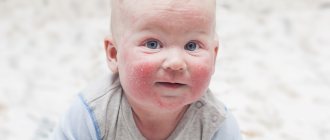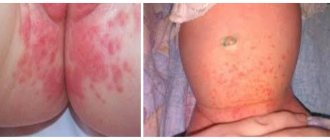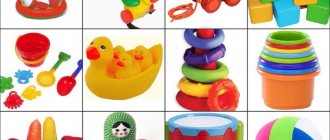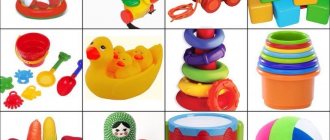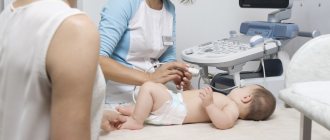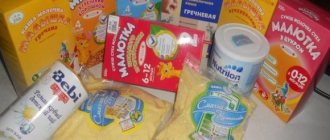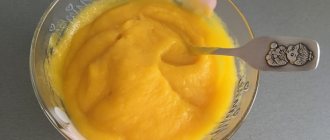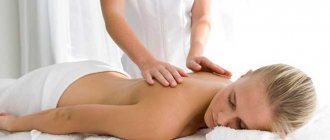What is atopic dermatitis
Atopic dermatitis is a chronic skin disease characterized by a relapsing course.
Babies with atopic dermatitis are bothered by itching and dry skin. Foci of inflammation can be located throughout the body, but they especially “love” children’s cheeks and folds, as well as the area under the diaper. Statistics indicate that atopic dermatitis occurs in every fifth baby [1]. Why is he dangerous? Lack of treatment can lead to the development of severe forms of atopic dermatitis, the spread of inflammation and the atopic march. In this condition, the disease begins to “march” through the child’s body, provoking the appearance or exacerbation of concomitant diseases. In 20-43% of cases, the development of bronchial asthma is possible, and twice as often - allergic rhinitis or eczema [2].
In addition, disruption of the hydrolipid barrier that occurs with atopic dermatitis in children can cause a secondary infection. Unfortunately, atopic dermatitis cannot be “outgrown.”
What should be the diet of the baby and mother with atopic dermatitis?
If atopic dermatitis is detected, the diet of a nursing mother involves avoiding the consumption of spicy, salty, sour, spicy foods and dishes. Additionally, you should refrain from including chocolate, strawberries, coffee, beans, nuts, cocoa, honey, citrus fruits, fatty broths and smoked meats in your diet. Undesirable products - confectionery, snacks and all fast food, factory juices, semi-finished products; hard cheeses, products rich in flavors and thickeners. Optimal nutrition for a nursing woman:
- Potatoes, cabbage, zucchini (boil or bake).
- Dairy products.
- Apples, pears - raw, boiled.
- Porridge made from barley, pearl barley, and corn.
- Beef.
- Rye bread, crackers.
- Compote made from natural fruits.
During lactation, it is not advisable for a woman to introduce new foods into her diet (exotic fruits, meat, drinks) if the reaction to them cannot be foreseen. Nutrition for atopic dermatitis in children involves switching to the use of hypoallergenic mixtures. Their presence on the menu helps strengthen the immune system and normalize the digestion process. Only a pediatrician can prescribe a certain mixture. The following options are used: 1. With soy protein: Humana SL, Bona soy, Enfamil soy. 2. With protein hydrolysate: Alfare, Damil Pepti, Nutrilon PeptiTSC. 3. With goat milk: Nanny. 4. With amino acids: Alfare Amino. 5. Fermented milk: Gallia Lactofidus, Agusha fermented milk.
If you are intolerant to cow protein, the optimal solution is to use Frisopep nutrition. This mixture can be used by children from the first days of their life. Each new product should be introduced no more than once every 2 weeks. This approach allows you to control the reaction of the child’s body to changes in diet. During the period of exacerbation of the symptoms of skin inflammation, the introduction of new complementary foods is contraindicated.
Symptoms of atopic dermatitis in children
According to recent studies [3], in 45% of babies, atopic dermatitis debuts between the ages of two and six months. In 60% of patients during the first year of life.
With atopic dermatitis in children, clinical symptoms and localization of inflammation largely depend on age. There are infant (up to one and a half years), child (from one and a half years to puberty) and adult phases. The following symptoms are common to all phases:
- Severe dryness of the skin (xerosis), which cannot be treated with regular baby cream .
- Redness and inflammation on the skin (especially symmetrical ones).
- Itching, causing severe discomfort to the child.
- Recurrent course (alternating periods of remissions and exacerbations). Moreover, in the cold season, deterioration is more often observed, and in the warm season, improvement is observed.
According to the nature of the course, acute and chronic stages of atopic dermatitis are distinguished, which are expressed by different signs (symptoms):
● Acute stage. Rough red spots (erythema), nodular rashes (papules), swelling, and crusts (including weeping) may appear on the baby's skin.
● Chronic stage. Accompanied by lichenification (thickening of the skin), cracks on the soles and palms, scratching, and increased pigmentation of the skin of the eyelids.
Why does atopic dermatitis occur?
Some useful dermatological theory. The disease is caused by a loss-of-function mutation in the skin protein filaggrin. Filaggrin is a special protein that takes part in the process of cell division in the upper layer of the skin - the epidermis and is necessary to maintain the barrier function of the skin. Thanks to it, adhesion and interaction between skin cells - corneocytes - is ensured. As a result of the genetic defect, disturbances occur in the structure of filaggrin, the connections between skin cells are weakened and transepidermal (transcutaneous) loss of moisture increases, which evaporates too quickly, leaving the skin dry and susceptible to microcracks.
Also, in the upper layers of the skin, filaggrin breaks down into organic acids (urocanic acid and pyrrolidone-5-carboxylic acid), which are natural moisturizing factors and help maintain normal skin pH. The subcutaneous fat layer of the skin, which is a key place for retaining moisture, becomes thinner, and the functioning of the sebaceous glands and cell division processes are disrupted.
Thus, this protein supports the most important functions of the skin. When a mutation occurs in the filaggrin gene, its decrease is noted, this leads to a disruption in the composition of the water-lipid mantle of the skin, excessive loss of moisture, and a decrease in the barrier function of the skin. All these changes lead to the development of atopic dermatitis. And this, in turn, leads to dry skin, inflammation, redness, and cracks. Itching appears, leading to scratching of the skin, increasing the risk of skin infection. The complete absence of filaggrin leads to the development of another disease - skin ichthyosis.
In addition, due to a violation of the composition of the water-lipid mantle of the skin, its microbiome (the totality of bacteria living on the skin) is disrupted and the risk of infection increases.
To understand this complex mechanism and the reasons for the development of atopic dermatitis, you can visualize the skin as a brick wall: cells are bricks, the water-lipid mantle is cement. With atopic dermatitis, lipid loss occurs, that is, the “cement” that should firmly hold our bricks – skin cells – is disrupted. The “wall” becomes unreliable, and the skin becomes fragile, permeable and vulnerable to irritants. A detailed analysis of the mechanisms of development of atopic dermatitis is important in order to understand the principles of treatment and prevention of exacerbations of atopic dermatitis.
Causes of atopic dermatitis in children
Atopic dermatitis can be considered a hereditary disease, because the most important role in its occurrence is played by a genetic factor [3]:
- In 80% of children, it occurs if both parents have or have had atopic dermatitis.
- In more than 50% of children - if at least one of the parents was sick, especially the mother (this doubles the risk of transmitting the disease “by inheritance”).
Some prenatal factors can also provoke atopic dermatitis in a baby: for example, poor nutrition of the expectant mother, contact with toxic substances, infections suffered during pregnancy, as well as bad habits and stress.
In addition, atopic dermatitis more often develops in babies who suffered oxygen deprivation during childbirth, were born prematurely and were bottle-fed (perinatal factors).
Causes
The leading cause of the development of skin pathology in newborns is hereditary predisposition. If the baby's parents suffer from allergic reactions, there is a high probability that the baby will also be predisposed to intolerance to specific irritants.
Atopic dermatitis in children under one year of age can be triggered by the following factors:
- Unfavorable hygienic environment - a contaminated room in which a newborn is located.
- Bad habits of the mother during pregnancy.
- Premature transfer of the baby to artificial feeding.
- Poor nutrition of a woman during pregnancy.
- Feeding a newborn with low-quality formula.
- Helminthiasis, which promotes the removal of useful substances from the body.
- Weakened immunity.
- Diseases of the mother during pregnancy.
Also, the development of atopic dermatitis in a newborn occurs when adults touch it with contaminated hands. Allergic skin lesions are directly related to baby food. Foods that cause exacerbation of atopic dermatitis: strawberries, wild strawberries, milk, honey, fish, beans and wheat flour. The likelihood of developing skin lesions increases when sweets, nuts, and citruses enter the body. In every 2 cases, inflammation of the epithelium can be provoked by the use of medications - local (if the drug is applied externally) or systemic (when the drugs are taken orally).
Diagnosis of atopic dermatitis in children
For a long time it was believed that atopic dermatitis in children is predominantly an allergic disease. However, it has now been proven that this is, first of all, a disease with dysfunction of the epidermis! And food allergies are detected only in 30-40% of children with atopic dermatitis.
The symptoms of atopic dermatitis are almost always influenced by certain environmental triggers. This could be chlorinated or “hard” water, soap, contact with an allergen, unfavorable climate and even stress. Another common trigger is bacteria that enter the skin through a damaged epidermal barrier.
Only a doctor (pediatrician, dermatologist, allergist) can make a diagnosis of “atopic dermatitis in children”! It takes into account the presence of external signs of disease and itching, as well as hereditary factors. Laboratory tests may be prescribed for children to carry out diagnostics. For example:
- General detailed (clinical) blood test.
- Biochemical general therapeutic blood test.
- General (clinical) urine analysis.
- Study of the level of total immunoglobulin E in the blood.
- Skin testing with allergens.
- Skin biopsy.
SKIN CARE FOR AN ALLERGIC CHILD
Atopic dermatitis
is an allergic disease.
Negative symptoms often appear in children in the first years of life. Redness of the skin, peeling, itching, cracks, crusts on the skin make babies and parents suffer. It is important to recognize the disease in time and, in case of complicated forms, to obtain advice from specialists. What are the effective measures for the treatment and prevention of atopic dermatitis in children? The main factors in the occurrence of the disease
are heredity and food allergies.
Contact with allergens also has a negative impact, they can be dust, pollen, and pet hair; chronic infectious diseases that provoke problems with the skin; frequent respiratory and viral infections, significantly worsening the immune system; transition from breastfeeding to artificial feeding. The goal of skin care for atopic dermatitis
is to maintain normal moisture, maintain or restore the protective layer, stimulate the growth of new cells instead of dead ones, and prevent irritation and damage to the upper layers of the skin.
SCIENTISTS HAVE FOUND THAT THE RISK OF GETTING ATOPIC DERMATITIS FOR A BABY FROM HEALTHY PARENTS IS NO MORE THAN 10-15%.
AT THIS TIME, IF ONE OF THE PARENTS HAD THIS DISEASE, THE RISK FOR THE CHILD INCREASES BY 50%, IF BOTH PARENTS - BY 80%. WHAT PRODUCTS SHOULD BE USED FOR MOISTURIZATION?
A baby with atopic dermatitis constantly needs emollients and moisturizers. During an exacerbation of the disease, they are applied to the skin up to 10 times a day, in normal times - 2-3 times a day. It is necessary to choose those cosmetics that simultaneously protect the skin from dryness and restore the lipid layer of the skin. These are emollient creams. Manufacturers usually write this on such products: “for dry, sensitive and atopic skin.”
DO NOT WIPE YOUR SKIN AFTER A BATH! IT IS EASY TO WET BLOTHED WITH A VERY SOFT TOWEL AND IMMEDIATELY, WITHOUT LEAVING THE BATHROOM, IN THE STEAM-RATED AIR, APPLY A SOFTENING-MOISTURIZER TO THE CHILD’S WET SKIN.
BASIC RULES FOR CARE OF THE SKIN OF AN ALLERGIC BABY
• Frequent bathing in good quality water (no chlorine).
• Moisturizing and nourishing the skin.
• Keep factors that aggravate the disease under control.
• Avoid exposure to irritating factors (perfumes, washing powders, synthetic fabrics).
• Avoid skin contact with hard, artificial fabrics and wool. Only natural, biologically pure fabric and clothing made from it should be placed on the body of an allergic child with atopic dermatitis.
• Monitor the temperature and humidity in the room (cool air with a humidity of at least 60%).
• It is also necessary to eliminate all “dust collectors” (cover bookshelves with glass, remove carpets, heavy drapes and curtains, duvets and pillows, etc.).
To enhance hydration and relieve irritation and itching, bath products AVEN (Trickzer bath), A-DERMA (bath product for atopic skin), LA ROCHE POSE (bath oil), BIODERMA (Atoderm oil) are added to the bath.
If bathing is contraindicated (acute period, wound healing) - micellar solution SENSIBIO H2 O from BIODERMA. Cleanser with a pH of no more than 5.5.
FOR CARE WE USE:
Mousses, creams, balms, thermal waters: BIODERMA (Atoderm line), AVEN (Trixera, Xerakalm lines), A-DERMA (Exomega line), URIAGE (Xemosis line), LA ROCHE-POSE (Lipikar line).
Treatment of atopic dermatitis in children
In modern medicine, there are three degrees of severity of atopic dermatitis in children:
- Easy. The child responds well to treatment, remission can last more than 10 months, the itching is minor, the redness is slight. Exacerbations occur no more than twice a year.
- Medium-heavy. Exacerbations occur 3-4 times a year, and periods of remission are reduced to 2-3 months. The therapy gives less pronounced results, the redness “stubbornly” returns.
- Heavy. Long-term exacerbations are interrupted by short periods of remission - up to one and a half months. Treatment helps little or for a short period of time; the baby’s behavior is greatly affected by itching [4].
At all stages of atopic dermatitis, pediatricians and dermatologists recommend emollients - cosmetic skin care products. They moisturize the skin and help restore the level of lipids - the most important structural components. During periods of exacerbation, emollients can be applied frequently and generously.
Pay attention to the composition; it is advisable that emollients are not addictive. Their main tasks are to help the skin produce its own lipids, providing effective hydration and softening. In addition, the constant use of emollients prolongs periods of remission and alleviates the symptoms of atopic dermatitis.
The Mustela Stelatopia line of cosmetics will help restore skin comfort for a long time! Stelatopia emollients are effective at all stages of atopic dermatitis , incl. at its first signs - increased dryness of the skin.
Studies have confirmed that the use of Stelatopia emollient cream can reduce the likelihood of developing atopic dermatitis by 51% ! [6]
Treatment (use of hormonal drugs) for atopic dermatitis in children can only be prescribed by a doctor, taking into account age, symptoms, concomitant diseases and test results. Self-medication can be dangerous!
- For external therapy for moderate and severe degrees of atopic dermatitis, topical glucocorticosteroids, topical calcineurin inhibitors and others are used.
- In case of mild disease, the use of Stelatopia Emollient Cream reduces the severity of inflammation after 32 hours, due to the presence of sunflower oil in the distillate [5].
- In systemic therapy, the drugs dupilumab, cyclosporine, glucocorticosteroids and others are used orally or in injection forms.
- To relieve itching - clemastine, hifenadine, cetirizine, chloropyramine, levocetirizine and others. The use of Stelatopia emollient cream as a cosmetic skin care product reduces the severity of itching in 80% of cases [7].
- Physiotherapy treatment may include phototherapy. Sometimes, in the treatment of atopic dermatitis, diet therapy, acupuncture, plasmapheresis and some other methods may be prescribed.
Is it possible to take water treatments?
An allergic process on the skin should not cause a complete refusal to carry out hygiene measures. It is not only possible to bathe a child, but also necessary. After water procedures, you should remove moisture with blotting movements, then apply moisturizers to the skin. Lotions and emulsions perform this function less well than creams and ointments. For hygiene procedures, the use of high temperature water and products with alkaline properties is contraindicated.
Tips for moms
To prevent the development of atopic dermatitis in a child under one year old, it is advisable for parents to undergo instruction from a pediatrician or neonatologist. Doctors of these specializations will advise on creating an optimal daily routine for a newborn, and advise on how to properly organize baby nutrition and care for the baby.
To prevent the appearance of atopic dermatitis, the following measures must be observed:
- Do not give up breastfeeding. Lactation helps strengthen the immune system, and breast milk is a hypoallergenic product.
- Provide the first complementary food of white or green vegetables. They are characterized by better tolerability and a low risk of developing allergies.
- Wear clothes made from natural fabrics - cotton, linen. This material promotes full penetration of air to children's skin and prevents excessive fogging.
- Avoid wearing clothes in bright colors. In its production, dyes are used that can provoke allergic reactions.
- Wash children's toys daily with a 2% baking soda solution.
- For washing, use only special baby powders intended for treating the clothes of a child whose age does not exceed 1 year. Such products contain hypoallergenic components that reduce the risk of developing inflammatory processes on children's skin.
- After each bowel movement and urination, the baby needs to carry out water hygiene procedures, and care should not be limited to just changing the diaper.
- To prevent irritation of children's delicate skin, the water that parents use to wash their child's clothes must be free of chlorine. This harmful compound can lead to the development of severe dermatological symptoms.
- Before touching a newborn's skin, an adult should wash their hands thoroughly with soap.
- After each water procedure, the baby’s skin should be blotted rather than rubbed.
- Do not use special baby soap often, but once a week.
Parents should remember that an infant has a weak immune system, so it is important to create favorable conditions to strengthen the protective properties of the child’s body. It is necessary to maintain cleanliness in the home and optimal air humidity, prevent the baby from hypothermia, eliminate diseases in a timely manner, and prevent them from becoming protracted.
Atopic dermatitis in children under one year of age is not only a consequence of improper care of the newborn, but also an individual characteristic of the child’s body. With an integrated approach, the disease can be completely eliminated, but to prevent recurrence of inflammation, it is necessary to strengthen the baby’s immunity, provide proper nutrition and care for him.
Prevention of atopic dermatitis in children
For atopic dermatitis, primary, secondary and tertiary preventive measures are distinguished.
Primary prevention
is aimed at preventing the occurrence of atopic dermatitis in children.
Recommended:
- Expectant mothers with a tendency to allergic reactions should exclude allergenic foods from their diet.
- Introducing complementary foods to babies begins at four months of age.
- Pregnant women and newborns at risk should take probiotics containing lactobacilli.
- Practice breastfeeding whenever possible.
- Eliminate exposure of your baby to tobacco smoke.
- Maintain humidity levels and regularly ventilate the children's room.
Secondary prevention
is aimed at eliminating risk factors that, under certain conditions (stress, weakened immunity, etc.) can lead to the occurrence, exacerbation and relapse of atopic dermatitis.
Recommended:
- Regular consultations with specialists.
- Maintaining awareness of new research and drugs in the treatment of atopic dermatitis.
3.Tertiary prevention
is a set of measures aimed at preventing exacerbations or development of complications of atopic dermatitis.
Recommended:
- Avoid contact of the baby with provoking factors: soap (it dries the skin), clothes made of rough or synthetic fabrics, low-quality cosmetics, etc.
- Take care of your child's skin and apply emollients on a regular basis, including during periods of remission.
- Bath your baby daily using cosmetic cleansers for atopic skin.
[1] Isaac Steering Committee. (1998). Worldwide variation in prevalence of symptoms of asthma. The Lancet, 351, 1225-1235. (International Committee on Asthma and Allergy in Childhood 1998. Worldwide differences in the prevalence of asthma symptoms. The Lancet, 351, 1225-1235). [2] Studies Watson W., 2011, Larsen F.S., 2002, Draaisma E., 2015, ISAAC Steering Committee, 1998. (Studies Watson W., 2011, Larsen F.S., 2002, Draaisma E., 2015 International Committee on the study of asthma and allergies in childhood, 1998). [3] Clinical guidelines. Atopic dermatitis, 2021. [4] Atopic dermatitis: recommendations for practitioners. Russian national consensus document on atopic dermatitis. Ed. P.M. Khaitova, A.A. Kubanova. M.: Pharmacus Print, 2002. 192 p. [5] ODT and inflammation June 2010 [6] Scientific dossier “Atopic-prone skin: latest discoveries” [7] Test report “Stelatopia” emollient cream, self-assessment by users
